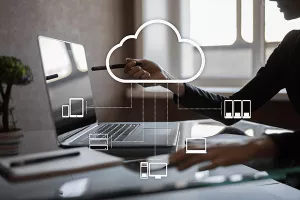It’s pretty clear that cloud services have become a core element of almost every infrastructure strategy to some degree. The numbers say it all: IDC says that the worldwide public cloud services market grew more than 24 percent year over year in 2020. And according to Deloitte, more than 90 percent of global enterprises will rely on hybrid cloud by 2022. But it isn’t just global giants that are turning to the cloud. In late 2020, 35 percent of small and medium-sized businesses spent between $600,000 and $1,200,00 annually on public cloud services.

1. What service level agreement (SLA) options do you offer?
Every business needs to focus on uptime, systems availability, network resiliency, and backup and disaster recovery. That’s because downtime can be incredibly costly. So here are some questions you’ll want to ask CSP contenders:
- How do you manage monitoring my systems?
- Are all of my systems and applications monitored?
- Do you guarantee global connectivity? Data speeds?
And one of the most important questions to ask the CSP is, what is your systems availability guarantee? While the industry standard for system availability is about 99.8 percent, StorageCraft Cloud Services delivers 99.999+ percent uptime using a highly distributed and fault-tolerant disaster recovery cloud.
2. How do you manage backup, failover, and disasters?
Here’s where the rubber really hits the road. Say disaster does strike. Losing your data can be a death sentence for your business. While local backups may be enough to recover IT systems from server failure and other typical problems, a site-wide disaster is another story. That’s where a cloud-based disaster recovery as a service (DRaaS) solution makes all the difference in the world. You’ll want advanced network-recovery options so you get back online quickly after a disaster by running your network in a recovery cloud, just like you’d run it onsite.
For next-level disaster recovery and total business continuity, look for a DRaaS solution that lets you configure the sequence, order, and timing for the recovery of each mission-critical system. Even better, that system should allow you to begin a site-wide failover process with a single click.
3. What third-party integrations do you offer?
The cloud is evolving quickly, with innovations arriving on the scene every day. With more and more third-party solutions becoming available, often using APIs, you need to know what you can and can’t connect to your systems.
4. How hard is it to change to another provider?
The same changes noted above may also lead you to decide to move your business to another CSP or even your own private cloud. With that in mind, it’s essential to know just how easy—or difficult—your CSP contender makes that process.
Conclusion
The cloud has changed the face of IT infrastructures everywhere. With pay-as-you-go models that keep your costs in line with usage, exceptional data security, and anywhere availability, a cloud services provider is worth considering for just about any size business.
Got more questions about the cloud and disaster recovery? Talk to a StorageCraft engineer today.
You May Also Like
- Backup and Disaster Recovery Data Resilience
Introducing Arcserve 10000 Series Appliances: Rapid Deployment. Enhanced Security. Simplified Compliance.
December 10th, 2024 - Backup and Disaster Recovery Business Continuity Cloud Compliance Cybersecurity Data Protection Data Resilience Data Storage Ransomware
The Importance of Versatile Cloud Data Protection Support in a Multicloud World
December 3rd, 2024 - Backup and Disaster Recovery Business Continuity Cybersecurity
Tech Conversations - Beyond the Arc: Cyber Confidence for Business Leaders
December 2nd, 2024